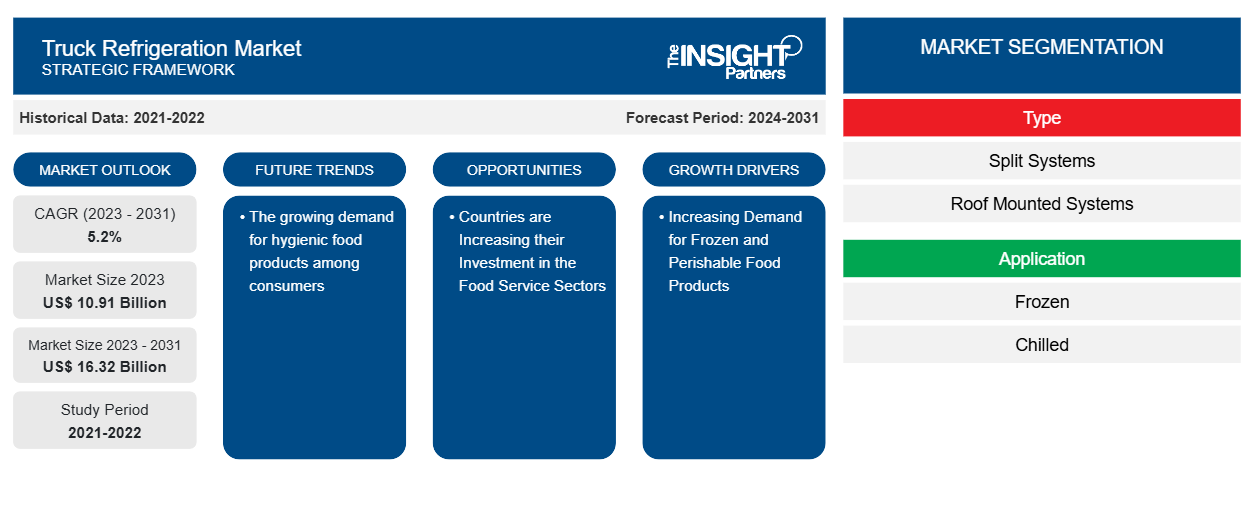트럭 냉장 시장 규모는 2023년 109억 1,000만 달러에서 2031년 1,632억 달러로 성장할 것으로 예상됩니다. 이 시장은 2023~2031년에 5.2%의 CAGR을 기록할 것으로 예상됩니다 . 소비자들 사이에서 위생적인 식품에 대한 수요가 증가하는 것은 트럭 냉장 시장의 주요 추세로 남을 가능성이 높습니다.
트럭 냉장 시장 분석
트럭 냉장 시장은 냉동 및 부패하기 쉬운 식품에 대한 수요 증가와 Subways, Domino, KFC 등과 같은 슈퍼마켓과 레스토랑의 확장으로 인해 빠른 속도로 성장하고 있습니다. 이 시장은 제조업체가 제품을 운송하는 동안 낭비를 줄이는 데 중점을 두고 꾸준히 확장되고 있습니다. 게다가 국가들은 식품 서비스 부문에 대한 투자를 늘리고 있으며, 트럭의 고급 온도 제어 및 모니터링 시스템에 대한 수요가 증가하면서 시장 성장에 수익성 있는 기회가 제공되고 있습니다.
트럭 냉장 시장 개요
트럭 냉장은 식품, 화학 물질, 의약품을 포함한 다양한 부패하기 쉬운 품목을 운송하기 위해 특정 온도를 유지하기 위해 트럭에 설치된 시스템을 말합니다. 이러한 시스템은 트럭의 엔진이나 독립 전원으로 구동되는 냉장 장치를 활용합니다. 트럭 냉장이 사용자에게 제공하는 상당한 이점은 예측 기간 동안 시장을 활성화하고 있습니다. 이러한 시스템은 제품의 유통기한을 늘리고 폐기물을 줄임으로써 운송 중에 최적의 온도를 유지하고 품목의 품질과 안전을 보존하는 데 사용됩니다.
귀하의 요구 사항에 맞게 이 보고서를 사용자 정의하세요
이 보고서의 일부 또는 국가 수준 분석, Excel 데이터 팩을 포함하여 모든 보고서에 대한 사용자 정의를 무료로 받을 수 있으며 신생 기업 및 대학을 위한 훌륭한 혜택과 할인 혜택을 이용할 수 있습니다.
-
이 보고서의 주요 시장 동향을 알아보세요.이 무료 샘플에는 시장 동향부터 추정 및 예측까지 다양한 데이터 분석이 포함됩니다.
트럭 냉장 시장 동인 및 기회
냉동 및 부패하기 쉬운 식품에 대한 수요 증가가 시장을 주도하고 있습니다.
냉동, 냉장 및 부패하기 쉬운 식품의 소비 증가는 가까운 미래에 글로벌 냉장 트럭 시장을 활성화할 것입니다. 소비자의 변화하는 라이프스타일과 식습관, 그리고 바쁜 일정은 냉장, 포장 및 냉동 식품에 대한 수요를 증가시키고 있습니다. 게다가, 시장은 다양한 온도 요구 사항을 가진 다양한 식품을 한 번에 운송해야 하는 필요성에 의해 주도되고 있습니다. 이러한 트럭은 운송되는 동안 식품을 안전하고 신선하게 유지하는 데 도움이 됩니다. 트럭에는 식품을 신선하고 안전하게 유지하는 냉장 장비가 장착되어 있습니다. 이러한 트럭은 생산 시설에서 창고 및 유통 장소로 신선한 식품과 음료를 운송합니다. 또한 가처분 소득이 증가함에 따라 편의 식품 소비가 증가합니다. 그러나 냉장 트럭에 대한 유리한 수요를 창출하는 레스토랑과 슈퍼마켓의 수가 증가함에 따라 시장이 활성화되고 있습니다.
국가들은 식품 서비스 부문에 대한 투자를 늘리고 있습니다. 트럭 냉장 시장의 기회
중국과 인도와 같은 국가들은 식품 서비스 부문에 대한 투자를 늘리고 있으며, 이는 글로벌 트럭 냉장 시장에서 기회를 창출할 것으로 예상됩니다. 인도, 중국, 브라질 등과 같은 신흥 국가에서 농업 산업 부문의 중요성이 높기 때문에 농산물을 보존하기 위한 트럭 냉장에 대한 수요가 증가합니다. 이러한 국가들은 콜드체인 물류를 확장하여 식품 서비스 부문에 많은 투자를 하고 있으며, 이로 인해 냉장 트럭에 대한 수요가 증가하여 예측 기간 동안 시장에서 상당한 성장 기회가 창출될 것으로 예상됩니다.
트럭 냉장 시장 보고서 세분화 분석
트럭 냉장 시장 분석에 기여한 주요 세그먼트는 유형, 응용 분야, 수직 및 차량 유형입니다.
- 트럭 냉장 시장은 유형에 따라 분할형 시스템과 루프 장착형 시스템으로 나뉩니다. 루프 장착형 세그먼트는 2023년에 더 큰 시장 점유율을 차지했습니다.
- 응용 프로그램을 기준으로 시장은 냉동 및 냉장으로 세분화됩니다. 냉동 세그먼트는 2023년에 더 큰 시장 점유율을 차지했습니다.
- 수직 기준으로 트럭 냉장 시장은 식품 및 음료, 제약 및 화학, 구급차로 세분화됩니다. 식품 및 음료 부문은 2023년에 더 큰 시장 점유율을 차지했습니다.
- 차량 유형 측면에서 시장은 트레일러와 중형 및 대형 상용차로 분류됩니다. 트레일러 세그먼트는 2023년에 더 큰 시장 점유율을 차지했습니다.
지역별 트럭 냉장 시장 점유율 분석
트럭 냉장 시장 보고서의 지리적 범위는 주로 북미, 아시아 태평양, 유럽, 중동 및 아프리카, 남미/남중미의 5개 지역으로 나뉩니다.
매출 측면에서 아시아 태평양 지역은 냉동 및 냉장 품목의 높은 소비로 인해 트럭 냉장 시장 점유율이 가장 높았습니다. 라이프스타일의 변화, 소비자 지출 증가, 편의성에 대한 수요 증가 등이 냉동 식품, 신선한 야채, 간식에 대한 수요를 증가시키고 있으며, 이는 예측 기간 동안 트럭 냉장 시장을 주도하고 있습니다. 또한 Daikin Industries, Ltd., Denso Corporation, Sanden 등 주요 업체의 존재는 시장에서 기회를 창출하고 있습니다. 이러한 업체는 고객에게 더 나은 솔루션을 제공하기 위해 혁신적인 트럭을 개발하고 시장을 활성화하는 데 참여하고 있습니다.
트럭 냉장 시장 지역 통찰력
Insight Partners의 분석가들은 예측 기간 동안 트럭 냉장 시장에 영향을 미치는 지역적 추세와 요인을 철저히 설명했습니다. 이 섹션에서는 북미, 유럽, 아시아 태평양, 중동 및 아프리카, 남미 및 중미의 트럭 냉장 시장 세그먼트와 지리에 대해서도 설명합니다.

- 트럭 냉장 시장의 지역별 데이터 얻기
트럭 냉장 시장 보고서 범위
| 보고서 속성 | 세부 |
|---|---|
| 2023년 시장 규모 | 109억 1천만 달러 |
| 2031년까지 시장 규모 | 163억 2천만 달러 |
| 글로벌 CAGR (2023-2031) | 5.2% |
| 역사적 데이터 | 2021-2022 |
| 예측 기간 | 2024-2031 |
| 다루는 세그먼트 |
유형별로
|
| 포함된 지역 및 국가 |
북아메리카
|
| 시장 선도 기업 및 주요 회사 프로필 |
|
트럭 냉장 시장 참여자 밀도: 비즈니스 역학에 미치는 영향 이해
트럭 냉장 시장 시장은 소비자 선호도의 변화, 기술 발전, 제품의 이점에 대한 인식 증가와 같은 요인으로 인해 최종 사용자 수요가 증가함에 따라 빠르게 성장하고 있습니다. 수요가 증가함에 따라 기업은 제품을 확장하고, 소비자의 요구를 충족하기 위해 혁신하고, 새로운 트렌드를 활용하여 시장 성장을 더욱 촉진하고 있습니다.
시장 참여자 밀도는 특정 시장이나 산업 내에서 운영되는 회사나 기업의 분포를 말합니다. 주어진 시장 공간에 얼마나 많은 경쟁자(시장 참여자)가 존재하는지 그 규모나 총 시장 가치에 비해 나타냅니다.
트럭 냉장 시장에서 운영되는 주요 회사는 다음과 같습니다.
- 캐리어 글로벌 코퍼레이션
- 다이킨공업 주식회사
- 덴소 주식회사
- 클링게 코퍼레이션
- 미쓰비시 중공업 주식회사
- 슈미츠 카고불
면책 조항 : 위에 나열된 회사는 어떤 특별한 순서에 따라 순위가 매겨지지 않았습니다.

- 트럭 냉장 시장 주요 업체 개요 알아보기
트럭 냉장 시장 뉴스 및 최근 개발
트럭 냉장 시장은 1차 및 2차 조사 이후의 정성적, 정량적 데이터를 수집하여 평가합니다. 여기에는 중요한 기업 간행물, 협회 데이터 및 데이터베이스가 포함됩니다. 다음은 트럭 냉장 시장과 전략의 개발 목록입니다.
- 2023년 11월, Daikin Industries, Ltd.는 대형 및 경량 상용차의 글로벌 허브인 SOLUTRANS에서 밴, 트럭 및 트레일러의 냉장을 위한 최신 솔루션을 발표했습니다. Daikin의 완전 전기 및 플러그인 하이브리드 제품군은 내연 기관의 배출가스를 줄입니다. 이 글로벌 제조업체는 새로운 트레일러 냉장 장치인 Exigo와 새로운 Daikin Telematics 연결 플랫폼을 포함하여 운송 냉장을 위한 혁신을 선보입니다. (출처: Daikin Industries, Ltd., 보도자료, 2023)
트럭 냉장 시장 보고서 범위 및 제공물
"트럭 냉장 시장 규모 및 예측(2021-2031)" 보고서는 아래 영역을 포괄하는 시장에 대한 자세한 분석을 제공합니다.
- 범위에 포함된 모든 주요 시장 세그먼트에 대한 글로벌, 지역 및 국가 수준의 시장 규모 및 예측
- 동인, 제약 및 주요 기회와 같은 시장 역학
- 주요 미래 트렌드
- 자세한 PEST/포터의 5가지 힘과 SWOT 분석
- 주요 시장 동향, 주요 업체, 규정 및 최근 시장 동향을 포괄하는 글로벌 및 지역 시장 분석
- 시장 집중도, 히트맵 분석, 유명 기업 및 최근 개발 사항을 포함하는 산업 환경 및 경쟁 분석
- 자세한 회사 프로필
- 과거 분석(2년), 기준 연도, CAGR을 포함한 예측(7년)
- PEST 및 SWOT 분석
- 시장 규모 가치/거래량 - 글로벌, 지역, 국가
- 산업 및 경쟁 환경
- Excel 데이터세트
최근 보고서
관련 보고서
사용 후기
구매 이유
- 정보에 기반한 의사 결정
- 시장 역학 이해
- 경쟁 분석
- 고객 인사이트
- 시장 예측
- 위험 완화
- 전략 기획
- 투자 타당성 분석
- 신흥 시장 파악
- 마케팅 전략 강화
- 운영 효율성 향상
- 규제 동향에 발맞춰 대응























 무료 샘플 받기 - 트럭 냉장 시장
무료 샘플 받기 - 트럭 냉장 시장